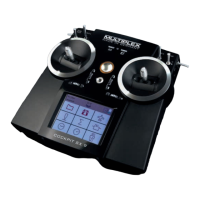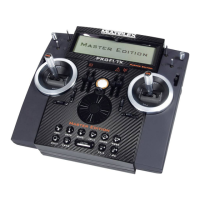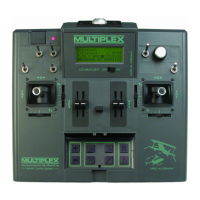ROYAL evo
Page 60
! We recommend that you have your radio control
system transmitters and receivers checked at
regular intervals (every 2 to 3 years) by an
authorised MULTIPLEX Service Centre.
! If any electrical device gets damp or wet, cease
operations immediately and disconnect the
power supply from it. Open the case if possible
and allow the unit to dry out thoroughly - pref-
erably for several days. After this carry out a very
careful check of all the functions. If you are not
certain that all is well, send the unit to an author-
ised MULTIPLEX Service Centre for checking
! The operation of this radio control system is ap-
proved for use on particular channels / transmit-
ter frequencies which vary from country to coun-
try. In some cases there are formalities such as
registration to be completed before you may use
the system. Please read the notes which are sup-
plied with this set on a separate sheet.
3.1. General safety notes
When building the model:
• All control surfaces and linkages must be installed
and set up in such a way that the control surfaces
move with complete freedom, and do not tend to
bind or move stiffly at the extremes of travel. Do
not limit the servo travel from the transmitter; it is
always better to adjust the servo output arms,
horns and pushrods instead. Always aim at mini-
mum possible lost motion (slop) in any linkage. All
these points help to minimise the load on the ser-
vos, ensuring that their maximum performance is
available to you, and that they will last as long as
possible. This also means maximum reliability and
safety for you and your models.
• Receiver, battery, servos and other RC components
and electronic units should be effectively protected
from vibration to avoid the danger of failure of any
electronic component. All the individual items are
supplied with operating instructions, and these
should be read thoroughly. Standard methods of
avoiding vibration include balancing propellers and
rotor blades before use, replacing damaged blades,
installing glowplug and petrol engines with effec-
tive vibration damping, replacing or repairing dam-
aged motors and engines if they do not run
smoothly, and so on.
• Don’t place cables under tension, and don’t bend
them tightly; protect all leads from rotating parts.
• Keep servo leads as short as possible, and don’t use
them unless absolutely necessary. If you must use
extension leads which are 30 - 50 cm or more in
length, fit a separation filter (ferrite ring) in each
lead, and ensure that the conductors are of ade-
quate cross-section to avoid voltage drop. We rec-
ommend at least 0.3 mm².
• Don’t coil up the receiver aerial, and do not shorten
it. Never deploy the aerial parallel to conductive
components such as metal pushrods, or inside a fu-
selage which has a shielding effect, i.e. made of or
reinforced with carbon fibre, or finished in metallic
paint. Don’t deploy the aerial on top of electrically
conducting model components. For large-scale
models we recommend the use of a whip aerial.
• Ensure that the receiver power supply is of ade-
quate capacity. If you are using servos rated at up to
about 40 Ncm you can calculate the required bat-
tery capacity using the following rule of thumb:
200.][ ×≥
If you have no problems with weight or space, it is
always better to select the next larger size of bat-
tery.
• Avoid any situation in which parts made of conduc-
tive material (e.g. metal linkage components or
pushrods) are in contact with each other, and move
against each other. This causes what is known as
electrical “noise”, which can interfere with the re-
ceiving system.
• Avoid interference pulses due to static charges or
powerful electric or electro-magnetic fields by tak-
ing appropriate suppression measures. These in-
clude suppressing electric motors with suitable ca-
pacitors, using shielded plug caps, ignition leads
and ignition units with spark-ignition petrol en-
gines; keeping the RC system components, includ-
ing aerial, wiring and batteries, well away from the
ignition circuit.
• Keep the receiving system a safe distance from
high-current leads (e.g. electric power system wir-
ing). High-current cables, especially those between
brushless electric motors and their controllers,
should be as short as possible (guide: max. 10 - 15
cm).
• When you have completed a new model, carry out
the programming of your transmitter in the peace
and quiet of your home. Check all the functions ca-
refully before flying the model. Take the time to
familiarise yourself with the programming proce-
dure and method of operating the transmitter be-
fore you use it for the first time to control a model.
Check the model regularly
• Ensure that all control surfaces and mechanical
linkages work smoothly, freely, and without slop.
• Check that pushrods, linkages, hinges etc. are stiff
enough for their purpose and in good condition.
• Carry out a visual check for fractures, cracks, signs of
stress in the model itself and on the components of
the RC system and power system.
• Check that all cables and connectors are in good
condition and are making sound contact.
• Check the state of the power system and its wiring,
including the switch harness, and check the exter-
nal condition of the cells. Regular care of the bat-
tery is important: monitor its voltage and capacity
using a charger and charging process designed for
the battery type you are using.

